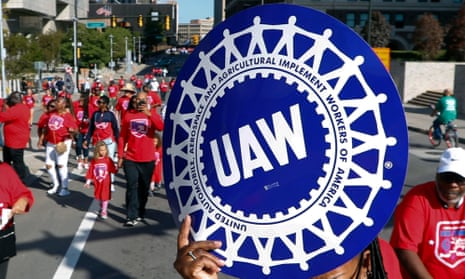
‘Biggest auto strike in generations’ looms – but why is it happening?
UAW workers at Ford, Stellantis and General Motors are ready to walk off the job if tentative agreements for new union contracts aren’t reached
As the deadline for “the biggest auto strike in generations” looms for 150,000 autoworkers, employees at Ford, Stellantis and General Motors are set to walk off the job at 11.59pm on 14 September if tentative agreements for new union contracts aren’t reached by then.
It’s the latest in a series of huge strikes called or threatened in the US by workers in industries including UPS workers, TV and movie production writers and actors, and hotel workers. If it happens, the strike could deal a significant blow to the US economy as well as the auto industry.
Why is it happening?
The union argues that autoworkers have never been fully compensated for the sacrifices they made after the 2008-09 financial crisis when they agreed to a raft of cuts to save the industry. The automakers received huge bailouts and soon returned to record profits.
Workers are pushing for at least a 40% wage increase over four years in a new contract, an end to two-tier wage systems in which new hires are paid significantly less for doing the same work, an increase to benefits for retirees and return of a defined pension instead of a 401k, reinstatement of cost of living adjustment raises, a 32-hour workweek, job security protections and protections for workers affected by plant closures.
The United Auto Workers (UAW) president, Shawn Fain, was elected to head the union as part of a reform campaign within its ranks, aimed particularly at taking a more aggressive approach toward bargaining with automakers after workers had taken concessions amid auto bankruptcies during the 2008 economic recession and have yet to regain those concessions and share in the quarter of a trillion dollars in profit the big three automakers have made in the last decade.
How likely is it to happen?
In late August, the UAW, which represents the workers at the big three automakers in the US, announced membership voted about 97% in favor of the strike authorization. The union has never gone on strike at the big three automakers simultaneously.
Morgan Stanley found that 82% of investors expect a strike, while 58% believe a stoppage is “extremely likely”.
When did UAW last strike?
Workers at General Motors last went on strike in 2019 during negotiations for the most recent union contract. It lasted 40 days and cost the carmaker $3.6bn. In 2019 contracts were reached with Fiat-Chrysler (now Stellantis) and Ford without a strike occurring.
How are talks going?
Not well. Fain has regularly posted video updates on negotiations for members in which he has thrown copies of proposals from the automakers in a trash bin, criticizing the shortcomings of the companies’ recent economic offers.
In the UAW’s most recent negotiation update, he criticized the counteroffers from Ford, Stellantis and General Motors, arguing they keep in place two-tiered wages for workers and rejected retirement and pension proposals; called wage proposals from Ford and GM “shameful and insulting”; and characterized Stellantis’s offer as “deeply inadequate”. The union has called for significant wage increases that reflect the salary increases of the automaker CEOs in recent years.
“It doesn’t make up for inflation, it doesn’t make up for decades of falling wages and it doesn’t reflect the massive profits we generated for this company,” said Fain.
after newsletter promotion
The automakers have criticized the union’s proposals and claimed they aren’t “feasible”.
What are the costs?
The automotive industry contributes about 3-3.5% of the US gross domestic product (GDP), the broadest measure of the economy.
Vehicle supply – just recovering from pandemic shortages – would be hit hard. A month-long strike at the three automakers could cut output by as many as 500,000 vehicles, according to Sam Fiorani, vice-president of global vehicle forecasting for AutoForecast Solutions.
Ten-day strikes at all three automakers could cost manufacturers, workers, suppliers and dealers more than $5bn, according to economic consulting firm Anderson Economic Group.
Will the White House get involved?
Business groups have been pushing the White House to intervene to avert a strike. White House officials have been in constant contact with the union and the three automakers, characterizing their role as beyond monitoring but short of intervening in the negotiations, as the administration continues to encourage all sides to come to a resolution to avert a strike.
President Joe Biden has said publicly he believed a strike would be averted, but White House officials, according to Politico, are “aware” that a strike is likely. Unlike the threatened train strikes in late 2022, Congress cannot impose a settlement on the UAW and the auto companies.